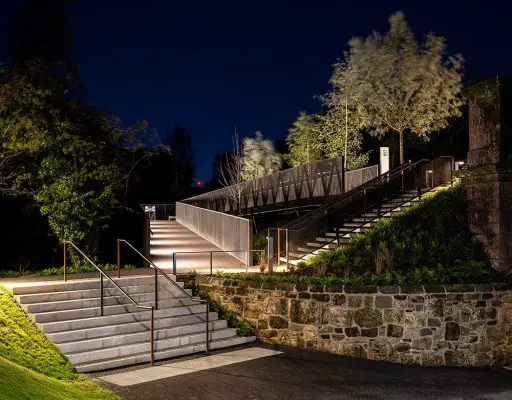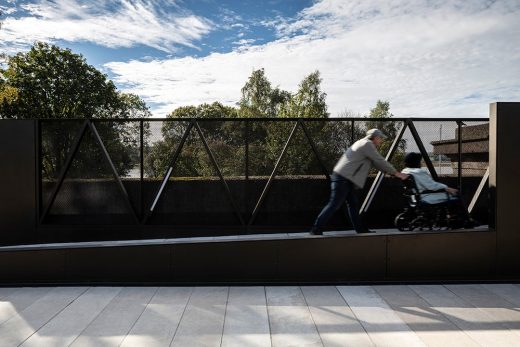The Bowline, Bowling Harbour Regeneration, Glasgow Landscaping Renovation, Scottish Architecture, Photography
Bowling Harbour Regeneration near Glasgow
7 Jan 2022
Design: rankinfraser landscape architecture
Location: Glasgow, Scotland, UK
The Bowline at Bowling Harbour Regeneration
Bowling Harbour’s viaduct swing bridge was originally constructed in 1896 to carry the Caledonian and Dunbartonshire Railway over the Forth & Clyde Canal. Following the closure of the Forth and Clyde Canal in 1963 and the Lanarkshire and Dunbartonshire Railway in 1964 the historically industrial area of Bowling Harbour fell into disrepair, losing its vibrant, bustling industry.
Identified in the early 2010s as a key regeneration opportunity by West Dunbartonshire Council; Scottish Canals, the custodian of the canal assets, worked with the local community and local authority to develop an award-winning masterplan for regeneration in the area.
Transformation works in the area commenced in 2014, including the refurbishment of the redundant railway arches into commercial units, bringing jobs and amenities to the local community.
New destination businesses are thriving in these units including cafes, a cycle shop, gift shop and activity centre offering a range of land and water-based activities for all ages. The railway arch refurbishment also uncovered the historic mechanisms for operating the swing bridge – the pioneering accumulator workings and a number of artefacts from the period.
Funding was secured to revive the abandoned, corroded railway viaduct swing bridge: the centre piece of the railway infrastructure spanning over the canal, which had once allowed the passing of vessels. Restored to its former glory, the refurbishment of the swing bridge laid the foundations for future phases of the transformation. The project was then awarded funding to transform the disused railway viaduct line into a linear park and active travel connection. The Bowline, provides a connection between the Forth & Clyde Canal towpath and the National Cycle Network route providing uninterrupted off-road access towards Loch Lomond & The Trossachs National Park
In 2017, following the refurbishment of the viaduct arches and the creation of commercial units funding was received to commence work on the transformation of the derelict railway line into a new active travel connection and linear park. Inspired by New York’s Highline, the Bowline provides uninterrupted off-road access towards Loch Lomond & The Trossachs National Park, along the National Cycle Network route.
The railway viaduct renovation incorporates two fixed bridges and a decommissioned swing bridge over the Forth & Clyde Canal. The fixed bridges respectively span A814 Dumbarton Road and the North Clyde Railway line. These substantial historic bridge structures have been carefully restored and conserved to remove years of decay and corrosion and enable new uses over.
The steel structures of the swing bridge and the fixed bridge across A814 Dumbarton Road have both been blast cleaned with full encapsulation to protect the local environment. Localised repairs were made where necessary and the structures were painted to give corrosion protection. All areas of conservation and restoration detailing involved the adherence to Historic Environment Scotland’s requirements to ensure the most sensitive and appropriate treatment of the structures.
Landscape Architectural Design
The landscape architectural design takes cues from the existing structures, with steel structures inserted within key locations in order to re-imagine the former industrial structure as a new destination and travel corridor. The access ramp and viewpoints are designed as contemporary reflections of the historic structures which they sit alongside, transforming the viaduct and providing it with a new lease of life for new generations.
The design of the new steel and iron elements seek to strike a balance between respecting the existing structures, but contrasting sufficiently to be understood as belonging to a different era. They bring the visitor into contact with historic elements which have been inaccessible for years, connecting east to west, touching the canal towpath, basin, swing bridge, arches, road and rail bridges, all the while affording views of the beautiful surrounding landscape.
Material choices and detailing reflects the industrial, robust nature of the site, with concrete, steel and iron used to create a ‘feel’ which is particular to this place. These reflect the existing concrete and metal structures in a way which is new, recognisable and exciting, further emphasising Bowling’s place on the map.
Planting complements and further emphasises the design through a combination of woodland planting in the east and west, out of which the viaduct and bridge structures emerge, and colourful carpets of ground cover species capable of growing within the thin soil depths on the bridges. Blocks of Birch trees evoke the period of dereliction which saw self-seeding of pioneer species, as nature began to re-emerge on the site.
Lighting Design
After darkness, lighting at the Bowline has been designed to enhance the newly restored Swing Bridge and Road Bridge historic girder bridge structures with integrated dynamic colour change LED feature lighting.
All feature and functional lighting designed for the Bowline project has been carefully considered in terms of lighting intensity, light colour and emissions, energy conservation and sustainability, environmental impact, especially glare and spill light controls in line latest Environmental lighting standards.
Design: rankinfraser landscape architecture
Client: Scottish Canals
Photography: Keith Hunter and Peter Sandground
The Bowline, Bowling Harbour Glasgow images / information received 070122 from
Location: Glasgow, Scotland, UK
Glasgow Buildings
Contemporary Architecture in Glasgow – architectural selection below:
Paisley Museum
Design: AL_A – Amanda Levete, Architects

image courtesy of architecture studio
Paisley Museum Renewal
Langside Halls Queen’s Park Glasgow
Scottish Architecture
Contemporary Architecture in Scotland
Edinburgh’s Ross Pavilion by wHY architecture

image courtesy of architects
Ross Pavilion Competition Winner
Perth City Hall Building Renovation by Mecanoo

image courtesy of architects office
Perth City Hall Building Renovation
Comments / photos for the The Bowline, Bowling Harbour Glasgow renewal design by rankinfraser landscape architecture page welcome
















